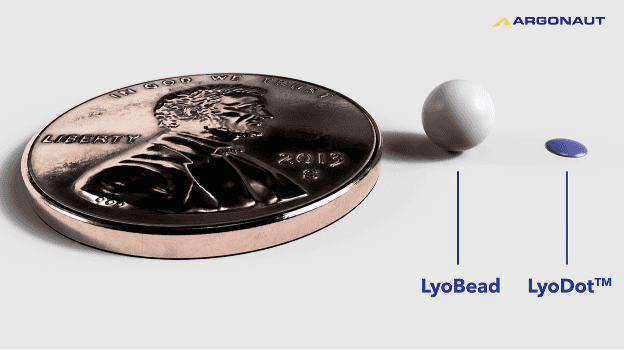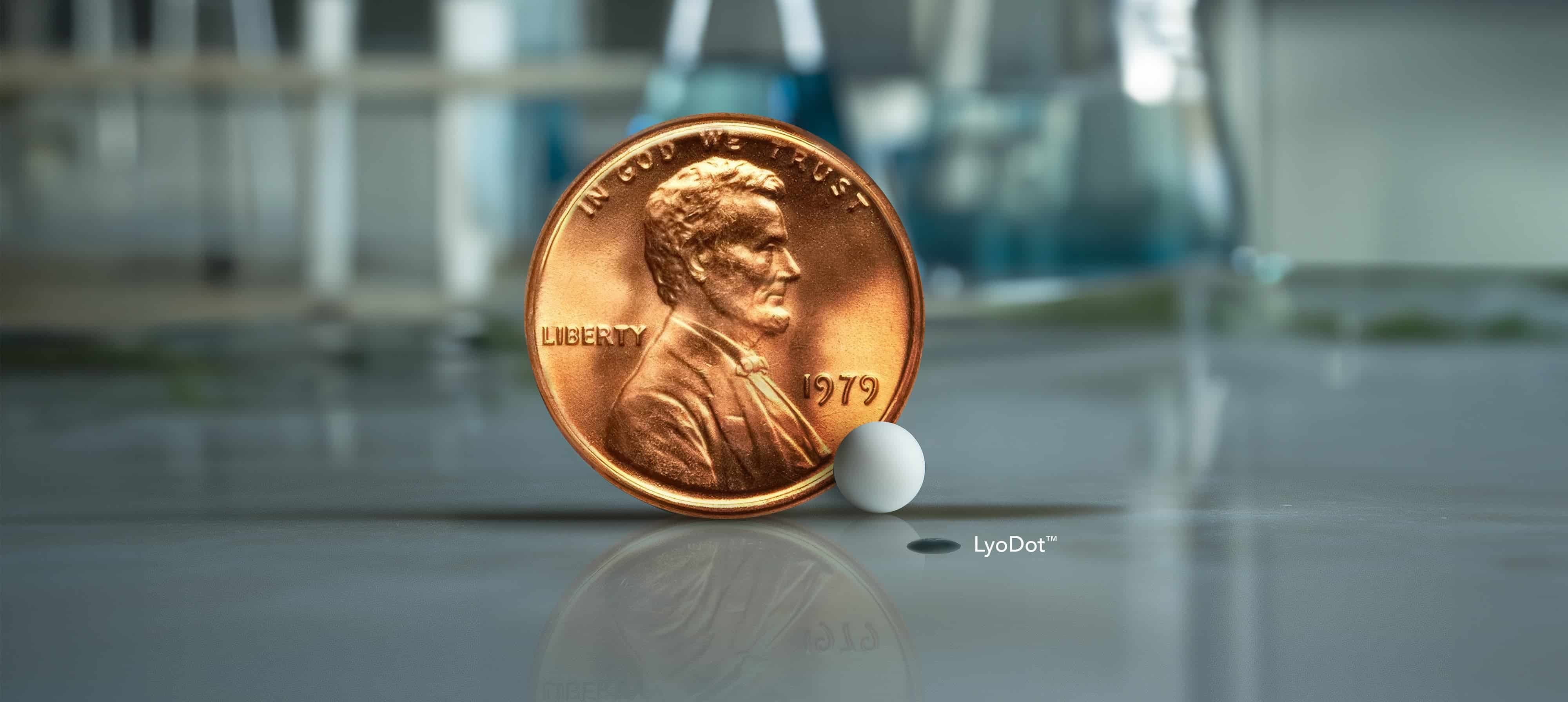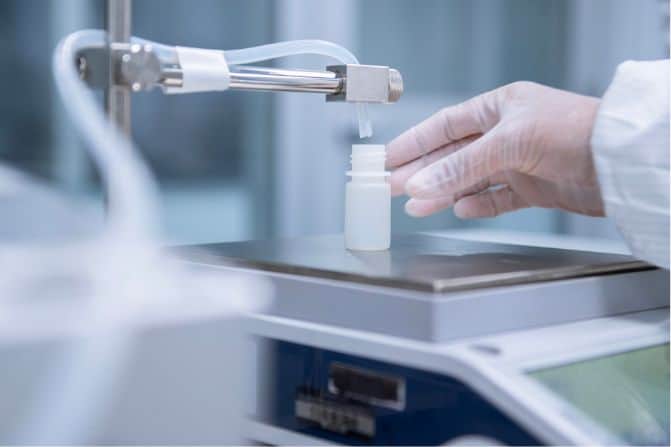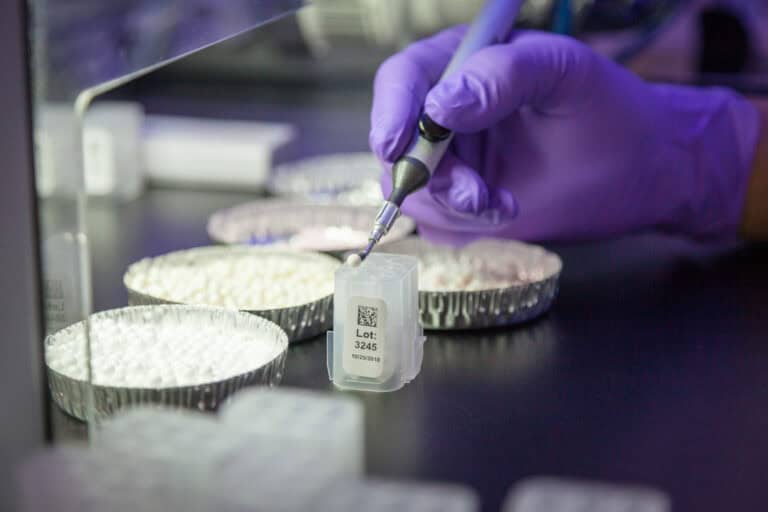LyoDots® are a unique miniaturized format of lyophilized reagent that can revolutionize diagnostic device development. In this two-part series we explore how instrument and assay designers can take advantage of this novel format. In Part 1, we highlight the characterization and functions of LyoDots, and in the Part 2, we uncover specific LyoDot benefits that can be incorporated during the diagnostic device development process.
Diagnostic Device Development with LyoDots
LyoDots are the results of lyophilized (freeze-dried) reagent technology designed for use in diagnostic assays and biochemical applications. They are small, uniformly shaped dots created through the lyophilization process, which involves freezing the liquid form of a reagent and then removing the water content through sublimation. The resulting LyoDots are a stable, dry product that retains the activity and functionality of the original reagent. LyoDots are based on proprietary Argonaut lyophilization technologies and are provided as a lyophilization service.

LyoDots are manufactured by dispensing liquid reagents onto a pretreated surface which is then subsequently freeze-dried. This process ensures reagents remain stable and effective. Importantly, the adherent surface on LyoDots ensures the lyophilized reagents maintain positional correctness and physical stability. The process allows each LyoDot to contain formulated reagent of between 0.1 – 10 µl.
Importance of LyoDots Size in Diagnostics Device Development
The size of LyoDots is under 4 mm in diameter with a height/ thickness less than 500 µm (0.5 mm). The dome formation of LyoDots has a reduced height dimension compared to a spherical bead shape. This is important as many in-vitro diagnostic applications utilize cartridges with microfluidic dimensions which cannot accommodate lyophilized beads with a diameter greater than 1 mm. The standardized flat, circular dome shape fits into smaller spaces compared to traditional lyophilized beads, enabling device miniaturization. See white paper for example of the utilization of LyoDots in qPCR assay.
LyoDots are composed of 0.1-10 µl reagent with diameter <4mm and height <0.5mm
LyoDots enable significant miniaturization of diagnostic reagents as it also results in reduced liquid requirement. This reduction in both size and volume has fundamental advantages in diagnostic device development. LyoDots allow assay developers and manufacturers to reduce cartridge or instrument footprint, lower consumable costs and simplify microfluidics, allowing greater miniaturization (1, 2, 3, and 4).
| LyoDot Feature | Benefit in Diagnostic Devices |
| 0.1ul to 10ul formulated reagent | Appropriate for individual reaction |
| <0.5 mm height | Can be used in channels, small reservoirs |
| <4 mm in diameter | Can be used in channels, small reservoirs |
| Adherent film | Anchored reagents, optimized rehydration |
LyoDot Advantages Beyond Form
Anchored in Place
LyoDots are supported by a mechanical film, which not only provides structural integrity but also makes them easy to handle. This latter feature is important for a seamless integration into device assembly lines using standard pick-and-place automation devices. LyoDots can be anchored in place, ensuring they remain stable and rehydrate uniformly, improving test reliability. While traditional lyophilized beads and cakes can move or break apart during transport, leading to inconsistent results.
Stable at Room Temperature
LyoDots maintain stability at room temperature, reducing the need for cold chain shipping and storage. Beyond the savings from removing cold chain logistics, LyoDots also have a positive environmental impact (e.g., reduced carbon footprint) compared to emissions from products that required cold-chain manipulation.
LyoDots do not require cold-chain logistics
Precise Placement
Robotic systems can be used for precise placement of LyoDots into diagnostic cartridges. Automated systems provide consistent positioning and reduces the risk of material loss. Proper placement and distance from welding points is necessary to prevent damage to LyoDots.
Efficient Rehydration
Ensuring complete and consistent rehydration is crucial for maintaining the performance of the diagnostic assay. LyoDots are designed to rehydrate efficiently, reducing the risk of incomplete reconstitution. LyoDots are stable at room temperature and during transport, preventing premature rehydration.
Overall Lower Cost
By reducing reagent volumes and improving efficiency, LyoDots can lower the overall cost of diagnostic tests compared to traditional lyophilization methods. This is particularly important for making diagnostic tests more affordable and accessible. Importantly, LyoDots are applicable for an individual reaction, whereas lyophilized cake or bead formats are often used to make a reservoir pool that then is fed into individual reactions.
LyoDots are applicable for individual reactions
Summary of Diagnostic Device Development with LyoDots
In summary, leveraging the benefits of LyoDots can transform your diagnostic device development, leading to more compact, efficient, and environmentally friendly solutions.
In Part 2 we go into further details on implementing LyoDots into instrumentation, cartridges, and diagnostic devices.
For more information on LyoDots or other lyophilized formats such as cakes and beads, Contact Us.
LyoDotsTM is trademarked by Argonaut Manufacturing Services.



